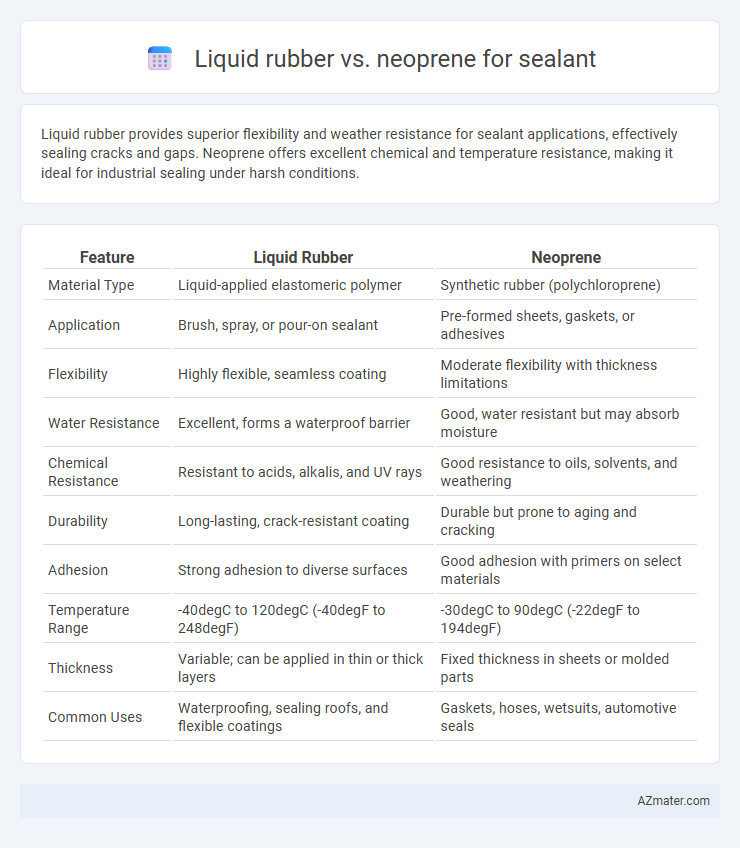Liquid rubber provides superior flexibility and weather resistance for sealant applications, effectively sealing cracks and gaps. Neoprene offers excellent chemical and temperature resistance, making it ideal for industrial sealing under harsh conditions.
Table of Comparison
| Feature | Liquid Rubber | Neoprene |
|---|---|---|
| Material Type | Liquid-applied elastomeric polymer | Synthetic rubber (polychloroprene) |
| Application | Brush, spray, or pour-on sealant | Pre-formed sheets, gaskets, or adhesives |
| Flexibility | Highly flexible, seamless coating | Moderate flexibility with thickness limitations |
| Water Resistance | Excellent, forms a waterproof barrier | Good, water resistant but may absorb moisture |
| Chemical Resistance | Resistant to acids, alkalis, and UV rays | Good resistance to oils, solvents, and weathering |
| Durability | Long-lasting, crack-resistant coating | Durable but prone to aging and cracking |
| Adhesion | Strong adhesion to diverse surfaces | Good adhesion with primers on select materials |
| Temperature Range | -40degC to 120degC (-40degF to 248degF) | -30degC to 90degC (-22degF to 194degF) |
| Thickness | Variable; can be applied in thin or thick layers | Fixed thickness in sheets or molded parts |
| Common Uses | Waterproofing, sealing roofs, and flexible coatings | Gaskets, hoses, wetsuits, automotive seals |
Introduction to Liquid Rubber and Neoprene Sealants
Liquid rubber sealants offer a flexible, waterproof coating ideal for roofing, basements, and automotive applications, curing into a durable, seamless membrane that resists UV rays, chemicals, and extreme temperatures. Neoprene sealants, made from chloroprene elastomer, provide excellent resistance to oil, weathering, and ozone, making them suitable for industrial sealing, gaskets, and marine applications. Both materials deliver superior adhesion and weather protection, but liquid rubber excels in ease of application and versatility, while neoprene is preferred for heavy-duty, chemical-resistant sealing needs.
Chemical Composition and Structure
Liquid rubber sealants primarily consist of synthetic latex polymers like polyisobutylene, forming flexible, waterproof films through cross-linked elastomeric chains. Neoprene, a chloroprene-based synthetic rubber, features a polychloroprene backbone that imparts superior resistance to oils, chemicals, and weathering due to its stable molecular structure. The distinct chemical compositions influence their sealing performance, with liquid rubber offering excellent adhesion and elasticity, while neoprene provides enhanced durability and chemical resistance in demanding environments.
Application Methods and Ease of Use
Liquid rubber offers versatility with brush, roller, or spray application, allowing seamless coverage on irregular surfaces and quick curing times that enhance user convenience. Neoprene sealants typically require more precise application with specialized tools like caulking guns, often demanding surface preparation for optimal adhesion. The ease of use for liquid rubber is generally higher due to its flexible application options and forgiving nature during curing, making it suitable for DIY projects and professional use alike.
Adhesion and Surface Compatibility
Liquid rubber offers superior adhesion on a variety of surfaces, including metal, concrete, wood, and plastic, making it highly versatile for sealing applications. Neoprene sealants provide strong bonding primarily on non-porous materials such as metals and certain plastics but may require primers for porous surfaces. The elastomeric properties of liquid rubber ensure durable, flexible seals that accommodate surface movement better than neoprene, which has more limited surface compatibility and elasticity.
Flexibility and Movement Accommodation
Liquid rubber exhibits superior flexibility and extends greater movement accommodation compared to neoprene, making it ideal for dynamic sealant applications. Its elastomeric properties enable it to stretch and rebound without cracking, effectively sealing joints subjected to frequent expansion and contraction. Neoprene offers moderate flexibility but tends to lose elasticity over time under continuous stress, limiting its effectiveness in areas with high movement.
Waterproofing Performance
Liquid rubber offers superior waterproofing performance due to its seamless application and excellent adhesion to various surfaces, creating a flexible, durable barrier that resists water penetration and weathering. Neoprene provides good waterproof sealing with moderate flexibility and resistance to abrasion, but may develop cracks or gaps over time under extreme temperature changes or prolonged exposure to UV rays. For long-lasting waterproofing, liquid rubber's elasticity and chemical resistance make it a more reliable choice in preventing leaks and maintaining seal integrity.
Resistance to UV, Chemicals, and Weathering
Liquid rubber offers superior UV resistance and flexibility, making it highly durable against prolonged sun exposure and harsh weather conditions. Neoprene excels in chemical resistance, especially against oils, solvents, and some acids, ensuring effective sealing in industrial environments. Both materials withstand weathering well, but liquid rubber's elasticity allows better adaptation to surface movement and temperature fluctuations over time.
Durability and Longevity
Liquid rubber sealants offer superior flexibility and UV resistance, making them highly durable for outdoor applications where temperature fluctuations and sun exposure are factors. Neoprene sealants provide excellent resistance to oils and chemicals but can degrade faster under prolonged UV exposure compared to liquid rubber. For long-lasting seals, liquid rubber generally outperforms neoprene in maintaining elasticity and preventing cracks over time.
Cost Comparison and Value
Liquid rubber sealants generally offer a lower upfront cost compared to neoprene, making them an economical choice for budget-conscious projects. Neoprene, while more expensive, provides superior durability and chemical resistance, translating into longer-lasting seals and reduced maintenance expenses over time. Evaluating the total cost of ownership, liquid rubber delivers strong initial savings, whereas neoprene offers greater long-term value through enhanced performance and longevity.
Best Uses: Choosing the Right Sealant for Your Project
Liquid rubber excels as a flexible, waterproof sealant ideal for roofing, foundation cracks, and ponds due to its UV resistance and strong adhesion to diverse surfaces. Neoprene offers excellent chemical resistance and durability, making it suitable for automotive gaskets, industrial seals, and marine applications where oil and fuel exposure occur. Selecting between liquid rubber and neoprene depends on environmental conditions, substrate compatibility, and specific performance needs such as flexibility, chemical exposure, and longevity.

Infographic: Liquid rubber vs Neoprene for Sealant
 azmater.com
azmater.com